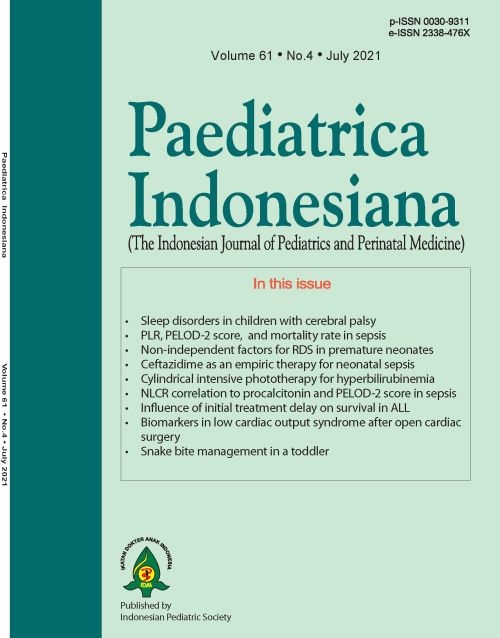Vitamin D and T- regulator cells are not independent factors for RDS in premature neonates
Abstract
Background The high morbidity and mortality of premature neonates remain significant problem in Indonesia with respiratory distress syndrome (RDS) as one of the most common problem. Vitamin D plays an important role in lung maturity. Vitamin D deficiency causes epithelial cell inflammation, leading to a higher risk of RDS. Previous studies suggest that T regulatory cells (Treg) in inflammatory diseases, such as RDS in neonates, are possibly linked to vitamin D deficiency.
Objective To determine the role of vitamin D on RDS and Treg cells in very premature or very low birth weight neonates.
Methods A prospective cohort study conducted on premature neonates in Neonatology Division, Department of Child Health, Dr. Cipto Mangunkusumo Hospital, Jakarta, Indonesia. Umbilical cord blood samples were collected to evaluate total vitamin D 25-OH levels and Treg cells. Subjects with RDS were evaluated until the end of the observation period.
Results The mean umbilical cord vitamin D level was 15.79 (SD 6.9) ng/mL, and 53% of the subjects were found to be deficient. As much as 65.1% of neonates had RDS. The mean Treg level was 11.38 (SD 2.45)%. No significant correlation was observed between vitamin D level and the occurrence of RDS (RR 0.87; 95%CI 0.56 to 1.34; P=0.53); vitamin D level and the dysregulation of Treg cells (RR 1.30; 95%CI 0.76 to 2.21; P=0.31) as well as between Treg dysregulation and RDS (RR 1.11; 95%CI 0.70 to 1.75; P=0.64). However, we found that RDS group had a lower gestational age and higher presentation of dysregulation Treg.
Conclusion In very premature or very low birth weight neonates, no association between occurence of RDS and vitamin D deficiency as well as Treg cell dysregulation.
References
2. Qari SA, Alsufyani AA, Muathin SH. Prevalence of respiratory distress syndrome in neonates. Egypt J Hosp Med . 2018;70:257–64. DOI: 10.12816/0043086.
3. Al-Beltagi M, Rowiesha M, Elmashad A, Elrifaey SM, Elhorany H, Koura HG. Vitamin D status in preterm neonates and the effects of its supplementation on respiratory distress syndrome. Pediatr Pulmonol. 2020 Jan;55:108-15. DOI: 10.1002/ppul.24552.
4. Dogan P, Ozkan H, Koksal N, Bagci O, Varal IG. Vitamin D deficiency and its effect on respiratory distress syndrome in premature infants: results from a prospective study in a tertiary care centre. Afri Health Sci. 2020;20:437-43. DOI: 10.4314/ahs.v20i1.50
5. Ataseven F, Aygün C, Okuyucu A, Bedir A, Kücük Y, Kücüködük S. Is Vitamin D Deficiency a risk factor for respiratory distress syndrome?. Int J Vitam Nutr Res. 2013;83:232-7. doi: 10.1024/0300-9831/a000165.
6. Gatera VA, Abdulah R, Musfiroh I, Judistiani RTD, Setiabudiawan B. Updates on the Status of Vitamin D as a Risk Factor for Respiratory Distress Syndrome. Adv Pharmacol Sci. 2018;8494816. DOI: 10.1155/2018/8494816
7. Hollis BW, Wagner CL. Assessment of Dietary Vitamin D Requirements During Pregnancy and Lactation. Am J Clin Nutr. 2004;79:717-26. DOI: 10.1093/ajcn/79.5.717
8. Baeke F, Takiishi T, Korf H, Gysemans C, Mathieu C. Vitamin D: Modulator of The Immune System. Curr Opin Pharmacol. 2010;10:482-96. DOI: 10.1016/j.coph.2010.04.001.
9. Hollis BW, Pittard WB 3rd. Evaluation of the Total Fetomaternal Vitamin D Relationships at term: evidence for racial differences. J Clin Endocrinol Metab. 1984;59:652-7. DOI: 10.1210/jcem-59-4-652.
10. Güven A, Ecevit A, Sözer O, Tarcan A, Tarcan A, Ozbek N. Correlation Between The cord Vitamin D Levels and Regulatory T cells in Newborn Infants. Eur J Pediatr. 2012;171:1161-166. DOI: 10.1007/s00431-012-1688-6.
11. Chambers ES, Hawrylowicz CM. The impact of vitamin D on regulatory T cells. Curr Allergy Asthma Rep. 2011 Feb;11:29-36. DOI: 10.1007/s11882-010-0161-8.
12. Sadat-Ali M, Al-Elq AH, Al-Shaikh IH, Al-Turki HA, Al-Ali AK, Al-Othman AA. Assessment of low vitamin D among Saudi Arabians. Did we overshoot the runway? Saudi Med J. 2014 Oct;35(10):1243-9. PMID: 25316470
13. Pagel J, Twisselmann N, Rausch TK, Waschina S, Hartz A, Steinbeis M, et al. Increased regulatory T cells precede the development of bronchopulmonary dysplasia in preterm infants. Front Immunol. 2020; 11;565257.
14. Lykkedegn S, Sorensen GL, Beck-Nielsen SS, Christesen HT. The Impact of Vitamin D on Fetal and Neonatal Lung Maturation. A Systematic Review. Am J Physiol - Lung Cell Mol Physiol. 2015;308:L587–602. DOI:10.1152/ajplung.00117.2014.
15. Matejek T, Zemankova J, Malakova J, Cermakova E, Skalova S, Palicka V. Severe vitamin D deficiency in preterm infants: possibly no association with clinical outcomes? J Matern Fetal Neonatal Med. 2020;1:1-9. DOI: 10.1080/14767058.2020.1762560.
16. Aly YF, El Koumi MA, Abd El Rahman RN. Impact of maternal vitamin D status during pregnancy on the prevalence of neonatal vitamin D deficiency. Pediatr Rep. 2013;5; 24-27. DOI: 10.4081/pr.2013.e6.
17. Correa-Rocha R, Pérez A, Lorente R, Ferrando MS, Leal M, Gurbindo D, et al. Preterm Neonates Show Marked Leukopenia and Lymphopenia that Are Associated with Increased Regulatory T-Cell Values and Diminished IL-7. Pediatr Res. 2012;71:590-97. DOI: 10.1038/pr.2012.6.
18. Zahran, Asmaa M, Hetta HF. Significant Correlation between Regulatory T Cells and Vitamin D Status in Term and Preterm Labor. J Reprod Immunol. 2018;129;15–22. DOI: 10.1016/j.jri.2018.07.004
19. Yadav S, Lee B, Kamity R. Neonatal Respiratory Distress Syndrome. In: StatPearls [serial on the Internet]. 2021 Jan [cited 2021 Feb 10]. Available from: https://www.ncbi.nlm.nih.gov/books/NBK560779/.
20. Mukherjee S, Giamberardino C, Thomas JM, Gowdy K, Pastva AM, Wright JR. Surfactant Protein A Modulates Induction of Regulatory T Cells Via TGF-?. J Immunol. 2012;188:4376-384. DOI:10.4049/jimmunol.1101775.
Copyright (c) 2021 Putri Maharani Tristanita Marsubrin, Agus Firmansyah, Rinawati Rohsiswatmo, Yuditiya Purwosunu, Zakiudin Munasir, Tetty Yuniati

This work is licensed under a Creative Commons Attribution-NonCommercial-ShareAlike 4.0 International License.
Authors who publish with this journal agree to the following terms:
Authors retain copyright and grant the journal right of first publication with the work simultaneously licensed under a Creative Commons Attribution License that allows others to share the work with an acknowledgement of the work's authorship and initial publication in this journal.
Authors are able to enter into separate, additional contractual arrangements for the non-exclusive distribution of the journal's published version of the work (e.g., post it to an institutional repository or publish it in a book), with an acknowledgement of its initial publication in this journal.
Accepted 2021-06-29
Published 2021-08-16













